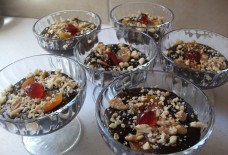Kindergarten Politics: How Arab Food Can Lead To Isolation in the American Cafeteria
A High School Cafeteria, courtesy of KPug1170By Emily Tain/Contributing Writer
So common is the trope of the school bully who demands lunch money and shoves classmates down on the playground. This type of bullying, physical and easy to spot, is what often comes to mind when talking about student relations. Less obvious, however, are the verbal microaggressions students intentionally or unintentionally throw at their classmates.
First Day of School
First Day of School, courtesy of KooBitsUpon going to school for the first time, children might experience a type of culture shock; perhaps they have only had contact with family members and friends of a certain background. Many traits their new classmates have, like hair color, skin tone, or clothing style, might be different and difficult to understand. Because of this, as well as the general impressionability of young children, students might carry biases and opinions that were taught to them by their families. This transition into a new environment can prove especially difficult for a child that is part of the minority in the school district, and even more so for children who are immigrants or a child of immigrants. Not knowing English as well as your classmates can lead to isolation; even just a difference in accent is easy for children to spot and target.
The Cafeteria
The cafeteria is a prime space for socialization in school, regardless of grade level or age. If one feels isolated there, it is possible that this isolation follows them into the classroom, onto the playground, or on the bus. This is why lunch is important to a child’s social life as well as their physical health. Kids are growing; limiting what they eat because of negative attention from peers can lead to harmful physical effects.
Courtesy of The Winchester StarThe average American lunch, as typified by movies and other forms of media, might have a peanut butter and jelly or ham and cheese sandwich, chips, a fruit or vegetable, and some type of sugary drink. If you are lucky, you could get leftover pizza or a Chef Boyardee. While meals for purchase can vary, most cafeterias have pizza, burgers, chicken nuggets, and a salad bar with occasional specialty dishes. Juxtaposed to this, many Arab American children eat stuffed grape leaves, hummus, za’atar, and falafel, among other Arab staples. While this is normal for them, and for most socialized adults, children with non-Arab roots might not understand a world beyond “American” food.
Changing for Peers
Being the only child with a “different” lunch can be anxiety-inducing, especially in the first few years of schooling. Because of this, Arab children might ask their parents to pack them “normal food” so that they can fit in and be accepted by their peers. This phenomenon goes hand-in-hand with the desire for children of Arab descent to be “whiter”—also known as “whitewashing.” Whitewashing, however, does not end at elementary school. For example, if a student has a traditionally Arab name, they may Americanize it so that their teachers and classmates don’t have trouble with its pronunciation. By changing their mannerisms and traits, these students are code-switching, a phenomenon in which someone shifts the language, dialect, or mannerisms they use depending on their surroundings.
Code-Switching
Courtesy of CFA Institute BlogsFor Arab American students, this might mean speaking in an “American” accent with their peers but speaking in another dialect or native language with family. Code-switching can be exhausting, especially for students whose home life is drastically different from their social life.
This is not to say that all students who eat American food are close-minded. Food-based social events can be a great way for a child to share a piece of their culture or background with their friends. These friends might enjoy what they tried so much that they bring it home to their families. Normalizing foods from a variety of backgrounds can educate families on other cultures, such as Arab culture.
Nature vs. Nurture is an ongoing discussion in the field of psychology. While some traits are genetic, much of a child’s worldview is influenced by their family or guardians. Therefore, it is imperative for parents to teach their children open-mindedness; if children are tolerant of differences, their peers will not feel as pressured to hide their heritage for the sake of their classmates’ and teachers ‘comfortability.’
Check out Arab America’s blog Here!







